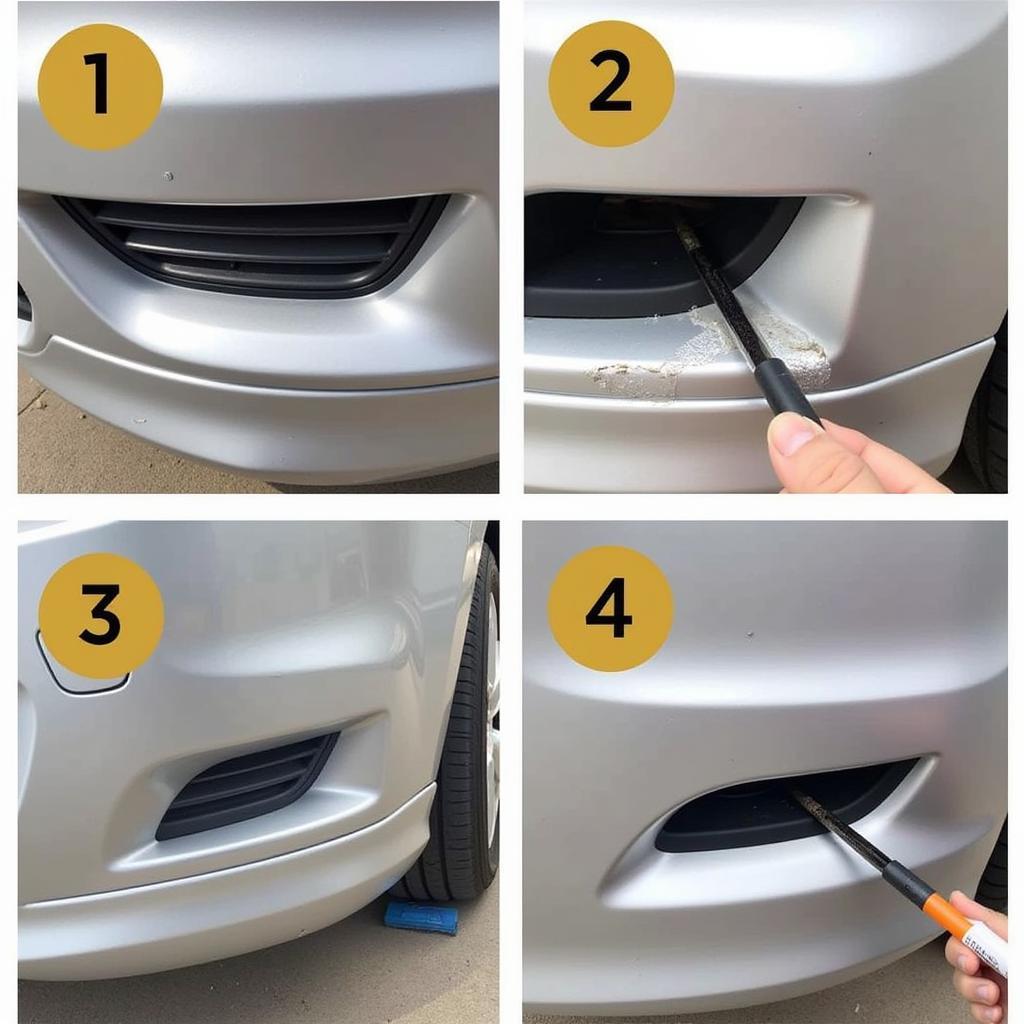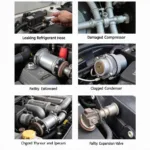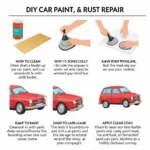Car bumper repair plastics are essential for fixing those unsightly cracks and dents that inevitably occur. This guide dives deep into the world of plastic bumper repair, covering everything from identifying the right plastic type to executing a professional-looking fix. Whether you’re a seasoned DIYer or a complete novice, you’ll find valuable insights and practical tips to restore your bumper to its former glory.
Choosing the correct repair method depends heavily on the type of plastic your bumper is made from. Common types include polypropylene (PP) and thermoplastic olefin (TPO), each requiring specific techniques and materials. Incorrectly identifying the plastic can lead to repair failure, so it’s crucial to get this step right. A simple heat test can often help determine the plastic type, and there are numerous online resources that can guide you through this process. Once you’ve identified the plastic, you can choose the appropriate repair kit, adhesive, or filler.
Understanding Car Bumper Plastics
Identifying the plastic type is the first step in successful car bumper repair. Most modern bumpers are made from either Thermoplastic Olefins (TPO) or Polypropylene (PP). TPO is known for its flexibility and resistance to cracking, while PP is slightly more rigid. Knowing the difference is vital as it dictates the type of repair materials you’ll need. You can often find the plastic type stamped on the inside of the bumper. If not, a simple heat test can help distinguish between the two. For instance, PP tends to melt quickly and cleanly, while TPO softens and stretches.
After identifying the plastic, the next step involves assessing the damage. Minor scratches and scuffs can often be addressed with sanding and repainting. Deeper cracks and dents require more involved repairs, such as plastic welding or using a plastic car bumper repair kit. For small cracks, you can use a car bumper repair epoxy.
Repairing Cracks and Dents in Car Bumper Plastics
Once you’ve identified the plastic and assessed the damage, you can begin the repair process. For small cracks, cleaning the area thoroughly and applying a suitable plastic adhesive is often sufficient. Larger cracks and dents may require plastic welding. This process involves melting filler material into the damaged area to rebuild the bumper’s structure. Ensure you have the correct type of welding rod for your bumper’s plastic type.
 Car Bumper Repair Using Plastic Welding
Car Bumper Repair Using Plastic Welding
How to Choose the Right Repair Kit
Choosing the right car repair filler plastic bumper is crucial for a lasting repair. Kits specifically designed for car bumper repair plastics often include everything you need, including cleaning agents, adhesives, fillers, and reinforcing mesh. When choosing a kit, ensure it’s compatible with your bumper’s plastic type. Some kits are designed for both PP and TPO, while others are specific to one type.
Do you wonder how to repair a plastic bumper on a car? This link provides a comprehensive guide.
Can I Use a Regular Soldering Iron?
Many people wonder, “can i repair car bumper with regular soldering iron?”. While a regular soldering iron can sometimes be used for minor repairs, it’s not ideal. Dedicated plastic welding tools offer better temperature control and are designed specifically for working with car bumper plastics. They provide more consistent results and reduce the risk of further damage.
“Accurate plastic identification is the cornerstone of a successful bumper repair. Using the wrong materials can lead to a weak repair that fails over time,” advises John Smith, Senior Automotive Technician at AutoFix Solutions.
Finishing Touches for Car Bumper Repair Plastics
After completing the repair, sanding and priming the area ensures a smooth, even surface for painting. Choose a paint that matches your car’s original color for a seamless finish. Applying a clear coat protects the paint and adds a professional touch.
“Investing in quality repair materials and taking your time with each step will yield professional-looking results,” adds Maria Garcia, Lead Collision Repair Specialist at Precision Auto Body.
In conclusion, repairing car bumper repair plastics is achievable with the right knowledge, tools, and materials. By carefully identifying the plastic type, assessing the damage, and following the appropriate repair techniques, you can restore your bumper’s appearance and save money on costly replacements.
FAQ
-
What are the most common types of car bumper plastics?
- The most common are Thermoplastic Olefins (TPO) and Polypropylene (PP).
-
How can I tell what type of plastic my bumper is made of?
- Look for a stamp on the inside of the bumper or perform a heat test.
-
Can I repair a cracked bumper myself?
- Yes, with the right tools and materials, DIY repairs are possible.
-
What is plastic welding?
- It’s a process of melting filler material into the damaged area to rebuild the bumper.
-
Do I need a special soldering iron for plastic welding?
- While a regular soldering iron can sometimes be used, a dedicated plastic welding tool is recommended.
-
What should I do after repairing the crack?
- Sand, prime, and paint the area to match the original color.
-
Where can I find car bumper repair kits?
- Automotive parts stores and online retailers offer a variety of kits.
Common Car Bumper Repair Scenarios and Questions
-
Scenario: Deep dent with paint damage.
-
Question: Can I repair this myself, or do I need a professional?
-
Scenario: Multiple small cracks and scratches.
-
Question: What’s the most cost-effective way to address these minor damages?
-
Scenario: Crack near the edge of the bumper.
-
Question: Will the repair hold up in this high-stress area?
Further Reading and Resources on CarRepairOnline
- Explore our detailed guide on plastic car bumper repair kit.
Need further assistance with your car bumper repair plastics project? Contact our 24/7 support team via WhatsApp: +1(641)206-8880 or Email: [email protected]. We’re here to help!


